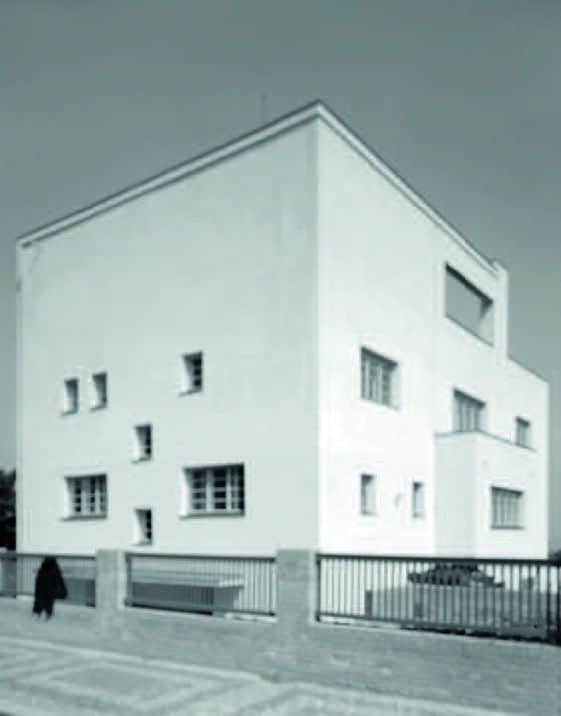Mariana Serranová and Edith Jeřábková’s interview with Rostislav Švácha
MS: This issue of Fotograf magazine includes a rich selection of image/photo material. Weʼre interested not only in how the cityʼs past compares with its present, but also in how Pragueʼs individual districts are doing from an architectural as well as urbanist perspective. The original city periphery, which was subject – mainly in the 1940s – to the romantic embrace of Modernism, has become part of the internal city area. Should we support such romanticising when contemplating the cityʼs architectural and urbanist aspects? And what about the periphery today?
RŠ: I think that the discovery of the periphery as something attractive relates, for example, to F.X. Šalda and the discovery of “new beauty” as he writes in the essay, Nová krása: její geneze a charakter / New beauty: its genesis and character, dating from the beginning of the 20th century. Therein Šalda speaks of the until-that-time unrecognised beauty of iron bridges, and afterward the inventory of new beauties began to expand. This is one of the most important trends in modern art – we begin to notice that which we had previously considered ugly and uninteresting. The periphery of the 1930s and 1940s discovered by Skupina 42 (Group 42) was very different from todayʼs periphery. It was half-industrial fringes of the town, fragments, bits of sorts of new buildings, tram (streetcar) depots, wood-fenced yards, garages – what we know from Skupina 42ʼs photos.
Today the periphery is what architect, Pavel Hnilička, calls “estate porridge.” In it you have a massive repository (dump) of everything imaginable: there you will find a petrol station, a highway on-ramp, also huge advertisements, a bit further a housing subdivision in a terrible, pseudo-post-modern style that I call “Beverly Hills.” Everything mixes together there and now itʼs a question of whether we see therein “new beauty.”
As early as the 1960s and 1970s some Western architects began to consider their estate porridge to be a new attractive aesthetic. Perhaps the most active were Robert Venturi and Denise Scott Brown, who found the beauty of Las Vegas, and published a famous book about it in 1972. In fact it was there in Learning from Las Vegas that they celebrate this estate porridge that began to develop here (in the Czech Republic) only after the revolution in 1989. But itʼs up to the individual to decide whether the current periphery is attractive to him or her, or not. Personally I donʼt find it attractive. The periphery known to Skupina 42 still had something to it, but the current periphery: itʼs just desperation and hopelessness. It has gravely destroyed the landscape, which the periphery of the 1930s and 1940s did as well, yet not to such an enormous extent. Todayʼs estate porridge spreads across the landscape like a plague.
#15 Prague
Content
- ––– Profiles
- Iren Stehli
- Viktor Kopasz
- Johana Pošová
- Markéta Kinterová
- Pavel Karous
- Tomáš Brabec
- Jáchym Kliment
- Markéta Othová
- Jiří Thýn
- Sylva Francová
- Skupina Ládví
- Petra Steinerová
- Ludmila Kadlecová
- Jiří Skála
- Jesper Alvaer
- SofijaSilvia
- Matthew Monteith
- Blazej Pindor
- Jiří Křenek
- Veronika Zapletalová
- Karin Muller
- Tim Eskild Jorgensen
- Krzysztof Zieliński
- Alena Kotzmannová
- Lukáš Jasanský a Martin Polák
- Tacita Dean
- Miroslav Machotka
- Dušan Pálka
- Rudo Prekop
- Karel Cudlín
- Peter Župník
- Štěpán Grygar
- Jiří Poláček
- Pavel Baňka
- Jaromír Čejka
- Jan Reich
- Josef Koudelka
- Václav Chohola
- Zdeněk Tmej
- Josef Prošek
- Miroslav Hák
- Josef Sudek
- ––– Theory
- History, not people, flows through the small streets
- Mariana Serranová and Edith Jeřábková's interview with Rostislav Švácha
- ––– Events
- 9th International Festival of Photography in Łódz
- "Great Hope" - Krakow Month of Photography
- ––– Reviews
- 50% Grey: Contemporary Czech Photography Reconsidered
- Anna Fárová (1928-2010)
- Interpret Štreit!
- Gustav Aulehla and the see-through mirror
Archive
- #45 hypertension
- #44 empathy
- #43 collecting
- #42 food
- #41 postdigital photography
- #40 earthlings
- #39 delight, pain
- #38 death, when you think about it
- #37 uneven ground
- #36 new utopias
- #35 living with humans
- #34 archaeology of euphoria
- #33 investigation
- #32 Non-work
- #31 Body
- #30 Eye In The Sky
- #29 Contemplation
- #28 Cultura / Natura
- #27 Cars
- #26 Documentary Strategies
- #25 Popular Music
- #24 Seeing Is Believing
- #23 Artificial Worlds
- #22 Image and Text
- #21 On Photography
- #20 Public Art
- #19 Film
- #18 80'
- #17 Amateur Photography
- #16 Photography and Painting
- #15 Prague
- #14 Commerce
- #13 Family
- #12 Reconstruction
- #11 Performance
- #10 Eroticon
- #9 Architecture
- #8 Landscape
- #7 New Staged Photography
- #6 The Recycle Image
- #5 Borders Of Documentary
- #4 Intimacy
- #3 Transforming Of Symbol
- #2 Collective Authorship
- #1 Face







